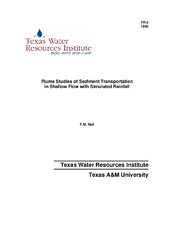| dc.description.abstract | This study involves four of the twelve major river basins of the state of Texas and is essentially a proposal to divert water from the Red River into the Trinity, Neches and Sabine River Basins. When first considered, it appears to be a rather unusual plan. It proposes to take water from the Red River at Lake Texoma, which is often of poor quality and in some areas of the basin scarce, and transport this water into a portion of the state that has an apparent abundance.
There are, however, numerous advantages to this plan. First, a dependable supply of water Is made available to the upper reaches of the receiving basins without the cost of reservoir construction. It also creates a potential for peak period hydroelectric power generation and supplies the lower portion of the basins with an increased water supply which can be put to beneficial use. This may involve water quality control of municipal and industrial pollution, control of salt water intrusion, or redistribution. In an age of grandiose water supply schemes, e.g., the California Water Plan 2 and the preliminary Texas Water Plan,3 the cost of this proposal is very reasonable.
Some of the disadvantages of this proposal are discussed briefly in the following paragraph. The Red River is an interstate stream; consequently, division of its waters among the states included in the basin must be by compact. Compact Commissioners representing the states of Texas, Oklahoma, Arkansas, and Louisiana, with a chairman representing the Federal Government, have been negotiating a Red River Compact. Most of the details have been worked out and the draft of this agreement is being reviewed by federal and state agencies. The Red River Compact will then need approval by the legislatures of each of the states and by the Congress before it will become effective. Until final arrangements have been made concerning the allocation of water, the proposed diversion cannot legally be made. Since the quality of the Red River water has been poor much of the time, the Corps of Engineers has begun work to alleviate the natural salt pollution. The states concerned have agreed to aid the Federal Government by close control of manmade pollutants. The quality of the Red River water is dependent upon these control programs. Finally, the development of this plan would require revision of the master plans for the specific basins because a number of existing reservoirs would be affected. If for no other reason, this study and the evolved proposal have been valuable as a training program for use of the many recently developed water resources planning techniques.
In order to insure a sense of direction, it seems apropos to present a brief outline of the study procedure.
Chapter II, entitled, "The Economic Development and Potential for the Red, Trinity, Neches and Sabine River Basins," is a general discussion of the economic factors as they are related to demand for water in each basin. In addition to a statewide outlook, a separate discussion for each basin is presented which includes future population projections. In closing this chapter, a table of the anticipated municipal and industrial water requirements is presented. Careful consideration of the information in this chapter is necessary for any type of water resources planning.
The largest section in this study is Chapter III, "The Water Resources of the Neches and Red River Basins." A comprehensive investigation of the water resources of all the basins in the proposal would have been desirable; however, the work required would have approached development of a master plan for a major portion of the state of Texas Detailed examination and research of the donating basin and for a single receiving basin was considered adequate for the objectives of this study. The specific subtopics which were discussed are too numerous to list here and are available in the Table of Contents section.
Chapter IV, "The Proposed Physical Plan," contains a description of the diversion facilities required to transfer excess surface water from Lake Texoma in the Red River basin to the three recipient basins.
Chapter V, "Summary and Conclusions," contains a restatement of some of the major features of the proposal and suggestions for further research. | en |


